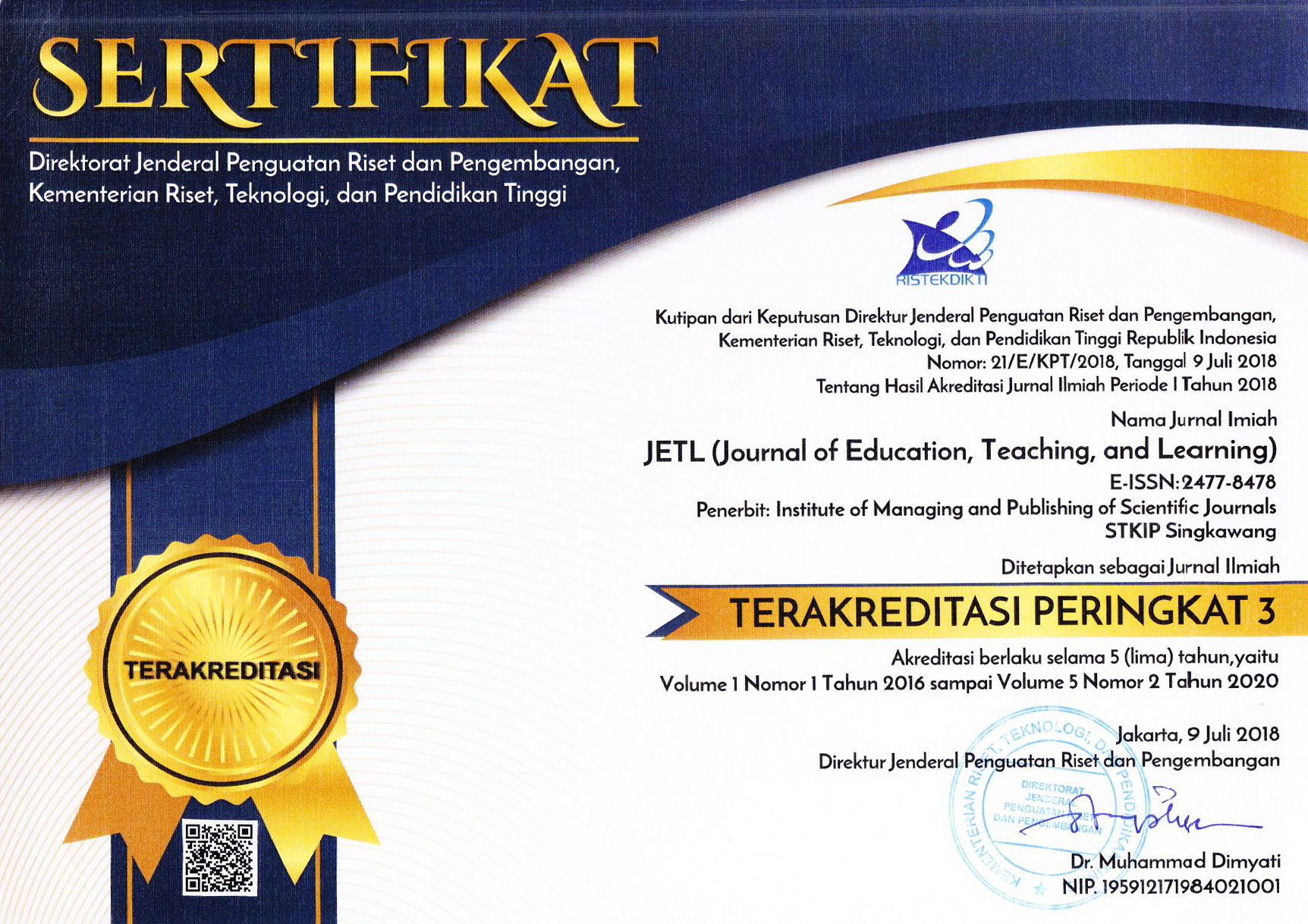Promoting Collaborative Pedagogy in Classrooms: Challenges and Solutions
Abstract
Collaborative pedagogy appears to be productive among students and thereby adopted in many classrooms to ensure that students are active participants in the knowledge production process. However, challenges exist among students, alongside their instructors, which hinders the active involvement of students in the collaborative knowledge production process. In the same vein, the study also examines the possible ways to navigate the challenges. The argument is located within social constructivism and conceptual analysis of collaborative pedagogy to explore the trajectories of collaborative classrooms in schools. In response to the challenges, the study proposed solutions that include promotion of unity in diversities among students, the introduction of cultural variations in classrooms, and instigation of student’s readiness to interact. The study concludes that collaborative knowledge construction is worthy of being promoted with the recommendation that schools should ensure that students are taught to be united in the process of generating knowledge and that there must be concerted efforts to teach different cultures in the system with student motivation for natural interest.
Keywords
Full Text:
PDFReferences
Abes, E. S., Jones, S. R., & McEwen, M. K. (2007). Reconceptualising the model of multiple dimensions of identity: The role of meaning-making capacity in the construction of multiple identities. Journal of college student development, 48(1), 1-22.
Alonso, F., Manrique, D., Martínez, L., & Viñes, J. M. (2015). Study of the Influence of Social Relationships among Students on Knowledge Building Using a Moderately Constructivist Learning Model. Journal of Educational Computing Research, 51(4), 417–439. https://doi.org/10.2190/EC.51.4.c
Altinyelken, H. K. (2012). A converging pedagogy in the developing world? Insights from Uganda and Turkey. Global education policy and international development: New agendas. issues and policies, 201-221. https://hdl.handle.net/11245/1.390543
Amineh, R. J & Asl, H. D. (2015). Review of Constructivism and Social Constructivism. Journal of Social Sciences, Literature and Languages. 1(1), 9-16.
Anfara Jr, V. A., & Angelle, P. S. (2007). Teachers as leaders: Collaborative leadership for learning communities. Middle School Journal, 38(3), 54-61.
Bikowski, D. (2015). The Pedagogy of Collaboration: teaching effectively within an evolving technology landscape. Innovation in English language teacher education, 223-231. https://www.britishcouncil.in/sites/default/files/tec14_papers_final_online.pdf#page=223
Borokhovski, E., Tamim, R., Bernard, R. M., Abrami, P. C., & Sokolovskaya, A. (2012). Are contextual and designed student–student interaction treatments equally effective in distance education? Distance Education, 33(3), 311-329. https://doi.org/10.1080/01587919.2012.723162
Bozalek, V., Carolissen, R., Leibowitz, B., Nicholls, L., Rohleder, P., & Swartz, L. (2010). Engaging with difference in higher education through collaborative inter-institutional pedagogical practices. South African journal of higher education, 24(6), 1023-1037. https://hdl.handle.net/10520/EJC37652
Bransford, J. D., Sherwood, R. D., Hasselbring, T. S., Kinzer, C. K., Williams, S. M. (1990). Anchored instruction: why we need it and how technology can help. In D. Nix & R. Sprio (Eds.), Cognition, education and multimedia. Hillsdale, NJ: Erlbaum Associates.
Caram, C. A., & Davis, P. B. (2005). Inviting student engagement with questioning. Kappa Delta Pi Record, 42(1), 19-23.
Chandran, D., & Alammari, A. M. (2020). Influence of Culture on Knowledge Sharing Attitude among Academic Staff in eLearning Virtual Communities in Saudi Arabia. Information Systems Frontiers, 1-10.
Clarke, P. A. J., & Kinuthia, W. (2009). A Collaborative Teaching Approach: Views of a Cohort of Preservice Teachers in Mathematics and Technology Courses. International Journal of Teaching and Learning in Higher Education, 21(1), 1-12. https://files.eric.ed.gov/fulltext/EJ896237.pdf
Colón García, A. (2017). Building a sense of belonging through pedagogical partnership. Teaching and Learning Together in Higher Education, 1(22), 1-6
Craig, J., Poe, M., & Gonzalez Rojas, M. F. (2010). Professional communication education in a global context: A collaboration between the Massachusetts Institute of Technology, Instituto Tecnológico y de Estudios Superiores de Monterrey, Mexico, and Universidad de Quintana Roo, Mexico. Journal of Business and Technical Communication, 24(3), 267-295. https://doi.org/10.1177%2F1050651910363269
Derry, S. J. (1999). A fish called peer learning: Searching for common themes. Cognitive perspectives on peer learning, 9(1), 197-211.
Duke, C. R. (2002). Learning outcomes: comparing student perceptions of skill level and importance. Journal of Marketing Education, 24(3), 203–17
Fredrickson, J. (2015). Online learning and student engagement: Assessing the impact of a collaborative writing requirement. Academy of Educational Leadership Journal, 19(3), 127.
Garandeau, C. F., Ahn, H. J., & Rodkin, P. C. (2011). The social status of aggressive students across contexts: The role of classroom status hierarchy, academic achievement, and grade. Developmental psychology, 47(6), 1699.
Gardner, M., & Elliott, J. (2014). The Immersive Education Laboratory: understanding affordances, structuring experiences, and creating constructivist, collaborative processes, in mixed-reality smart environments. EAI Endorsed Transactions on Future Intelligent Educational Environments, 14(1), 1-13. http://repository.essex.ac.uk/id/eprint/10615
Gilles, C., Wilson, J., & Elias, M. (2010). Sustaining teachers' growth and renewal through action research, induction programs, and collaboration. Teacher Education Quarterly, 37(1), 91-108. https://eric.ed.gov/?id=EJ872651
Harris, C., & Harvey, A. N. (2000). Team teaching in adult higher education classrooms: Toward collaborative knowledge construction. New Directions for Adult and Continuing Education, 87, 25-32.
Hiep, P. H. (2007). Communicative language teaching: Unity within diversity. ELT journal, 61(3), 193-201.
Ismail, M., Diah, N. M., Ahmad, S., & Rahman, A. A. (2011). Engaging learners to learn tajweed through active participation in a multimedia application (TaLA). In 3rd International Conference on Advances in Computing, Control and Telecommunication Technologies (pp. 88-91).
Kajana, S. M. (2017). LITERATURE ANALYSIS FOR ORDINARY LEVEL. Dodoma-Tanzania: Sam Elly Press.
Keumala, M., Samad, N. M. A., Samad, I. A., & Rachmawaty, N. (2019). The Influence of Socio Cultural and Educational Background on EFL Learners’ Motivation. Indonesian TESOL Journal, 1(1), 67-77. https://doi.org/10.24256/itj.v1i1.556
Kim, B. (2001). Social constructivism. Emerging perspectives on learning, teaching, and technology, 1(1), 16.
Kleine Staarman, J, Krol, K, Van der Meijden, H (2005) Peer interaction in three collaborative learning environments. Journal of Classroom Interaction 40(1), 29-39.
Kukla, A. (2000). Social Constructivism and the Philosophy of Science. New York: Routledge.
Laal, M., & Ghodsi, S. M. (2012). Benefits of collaborative learning. Procedia-social and behavioral sciences, 31, 486-490.
Lainema, T. (2009). Perspective making: Constructivism as a meaning-making structure for simulation gaming. Simulation & Gaming, 40(1), 48-67.
Larsen-Freeman, D. (2012). From Unity to Diversity: Twenty-Five Years of Language-Teaching Methodology. In English teaching forum (Vol. 50, No. 2, pp. 28-38). US Department of State. Bureau of Educational and Cultural Affairs, Office of English Language Programs, SA-5, 2200 C Street NW 4th Floor, Washington, DC 20037.
Le, H., Janssen, J., & Wubbels, T. (2018). Collaborative learning practices: teacher and student perceived obstacles to effective student collaboration. Cambridge Journal of Education, 48(1), 103-122. https://doi.org/10.1080/0305764X.2016.1259389
Le, H., Janssen, J., & Wubbels, T. (2018). Collaborative learning practices: teacher and student perceived obstacles to effective student collaboration. Cambridge Journal of Education, 48(1), 103-122. https://doi.org/10.1080/0305764X.2016.1259389
Lomangino, A. G., Nicholson, J., & Sulzby, E. (1999). The influence of power relations and social goals on children’s collaborative interactions while composing on computer. Early Childhood Research Quarterly, 14(2), 197-228.
Maor, D. (2003). The teacher's role in developing interaction and reflection in an online learning community. Educational Media International, 40(1-2), 127-138.
McGee, S. J. (2001). Analysing literature. Salina, Kansas: Longman. Retrieved from http://wps. ablongman. com/wps/media/objects/327/335558/AnalyzingLit. pdf.
McKenna, A. F., Yalvac, B., & Light, G. J. (2009). The role of collaborative reflection on shaping engineering faculty teaching approaches. Journal of Engineering Education, 98(1), 17-26.
McMahon, M. (1997, December). Social constructivism and the World Wide Web-A paradigm for learning. In ASCILITE conference. Perth, Australia (Vol. 327).
Moore, M. G. (1989). Three types of interaction. American Journal of Distance Education,3(2), 1–7. https://doi.org/10.1080/08923648909526659
Newman, F., & Holzman, L. (2013). Lev Vygotsky (classic edition): Revolutionary scientist. Psychology Press. https://doi.org/10.4324/9780203758076
Nir, A. E. (2002). School-based management and its effect on teacher commitment. International Journal of leadership in Education, 5(4), 323-341.
Omodan, B. I., & Tsotetsi, C. T. (2020). Decolonisation of knowledge-construction in university classrooms: the place of social constructivism. African Journal of Gender, Society and Development (formerly Journal of Gender, Information and Development in Africa 9(2), 183-204. https://doi.org/10.31920/2634-3622/2020/9n2a10
Palloff, R., & Pratt, K. (2003). The virtual student: A profile and guide to working with online learners. San Francisco, CA: Jossey-Bass.
Parker, W. (2010). Listening to strangers: Classroom discussion in democratic education. Teachers College Record, 112(11), 2815-2832.
Paswan, K. A., Young, J. A, (2002). Student evaluation of instructor: a nomological investigation using structural equation modeling. Journal of Marketing Education, 24(3), 193–202.
Radulović, M., Vesić, D., & Malinić, D. (2020). Cultural capital and students’ achievement: The mediating role of self-efficacy. Sociologija, 62(2), 255-268.
Reichl, C., Wach, F.-S., Spinath, F. M., Brünken, R., & Karbach, J. (2014). Burnout risk among first-year teacher students: The roles of personality and motivation. Journal of Vocational Behavior, 85(1), 85–92. https://doi.org/10.1016/j.jvb.2014.05.002
Reznitskaya, A., Kuo, L. J., Clark, A. M., Miller, B., Jadallah, M., Anderson, R. C., & Nguyen‐Jahiel, K. (2009). Collaborative reasoning: A dialogic approach to group discussions. Cambridge journal of education, 39(1), 29-48.
Richmond, V. P. (1990). Communication in the classroom: Power and motivation. Communication Education, 39(3), 181-195. https://doi.org/10.1080/03634529009378801
Robinson, K. (2013). The interrelationship of emotion and cognition when students undertake collaborative group work online: An interdisciplinary approach. Computers & Education, 62, 298-307. http://dx.doi.org/10.1016/j.compedu.2012.11.003
Robinson-Wood, T. (2016). The convergence of race, ethnicity, and gender: Multiple identities in counseling. Sage Publications.
Ross, C. E., & Broh, B. A. (2000). The roles of self-esteem and the sense of personal control in the academic achievement process. Sociology of education, 270-284.
Salamone, F. A. (1997). Ethnicity and Nigeria since the end of the civil war. Dialectical anthropology, 22(3/4), 303-333.
So, H. J., Seah, L. H., & Toh-Heng, H. L. (2010). Designing collaborative knowledge building environments accessible to all learners: Impacts and design challenges. Computers & Education, 54(2), 479-490.
Thomas, A., & Bendixen, M. (2000). The management implications of ethnicity in South Africa. Journal of International Business Studies, 31(3), 507-519.
Thompson, R., Kitchie, L., & Gagnon, R. (2011). Constructing an online professional learning network for school unity and student achievement. Corwin Press.
Vygotsky, L. 1986. Thought and language. Cambridge, MA.: MIT Press
Willis, J. (2014). Making space to learn: Leading collaborative classroom design. Journal of Educational Leadership, Policy and Practice, 29(1), 3-16.
Young, M. R., Klemz, B. R., Murphy, J. W. (2003). Enhancing learning outcomes: the effectsof instructional technology, learning styles, instructional methods, andstudent behavior. Journal of Marketing Education, 25(2),130–42.
Zhou, Q., Suraworachet, W., Pozdniakov, S., Martinez-Maldonado, R., Bartindale, T., Chen, P., ... & Cukurova, M. (2021). Investigating students’ experiences with collaboration analytics for remote group meetings. In International Conference on Artificial Intelligence in Education (pp. 472-485). Springer, Cham.
DOI: http://dx.doi.org/10.26737/jetl.v6i2.2598
Refbacks
- There are currently no refbacks.

This work is licensed under a Creative Commons Attribution-NonCommercial 4.0 International License.
Published by:
Institute of Managing and Publishing of Scientific Journals STKIP Singkawang
Sekolah Tinggi Keguruan dan Ilmu Pendidikan (STKIP) Singkawang
Address : STKIP Singkawang, Jalan STKIP - Kelurahan Naram Singkawang, Kalimantan Barat, INDONESIA, 79251
No. Telp. : +62562 420 0344
No. Fax. : +62562 420 0584
JETL (Journal of Education, Teaching, and Learning)
e-ISSN : 2477-8478
p-ISSN : 2477-5924

Editor in Chief Contact: [email protected] / Wa: +6282142072788
Publisher Contact: [email protected] / Wa: +6282142072788
Management Tools
JETL Indexed by:
JETL (Journal of Education, Teaching, and Learning) is licensed under a Creative Commons Attribution-NonCommercial 4.0 International License.











